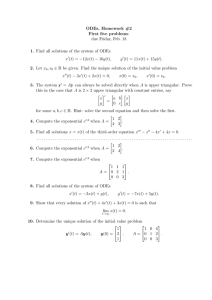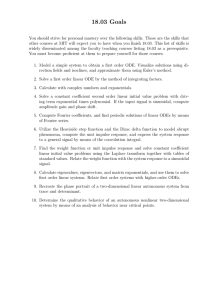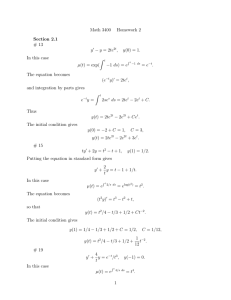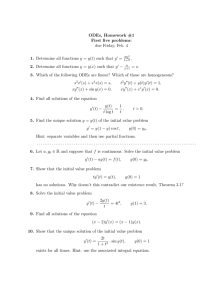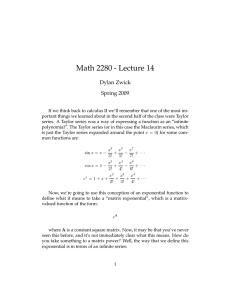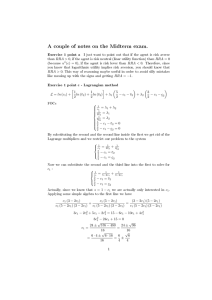Introduction to variation of parameters for systems
advertisement
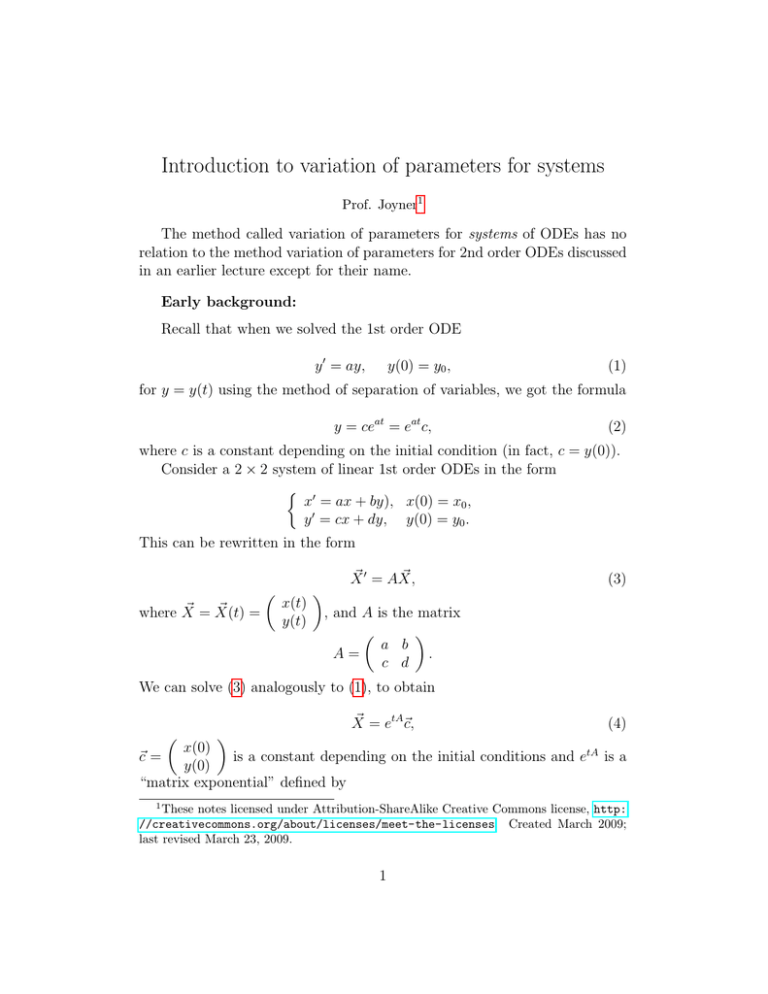
Introduction to variation of parameters for systems Prof. Joyner1 The method called variation of parameters for systems of ODEs has no relation to the method variation of parameters for 2nd order ODEs discussed in an earlier lecture except for their name. Early background: Recall that when we solved the 1st order ODE y 0 = ay, y(0) = y0 , (1) for y = y(t) using the method of separation of variables, we got the formula y = ceat = eat c, (2) where c is a constant depending on the initial condition (in fact, c = y(0)). Consider a 2 × 2 system of linear 1st order ODEs in the form 0 x = ax + by), x(0) = x0 , y 0 = cx + dy, y(0) = y0 . This can be rewritten in the form ~ = X(t) ~ where X = ~ 0 = AX, ~ X x(t) , and A is the matrix y(t) a b A= . c d (3) We can solve (3) analogously to (1), to obtain ~ = etA~c, X (4) x(0) is a constant depending on the initial conditions and etA is a y(0) “matrix exponential” defined by ~c = 1 These notes licensed under Attribution-ShareAlike Creative Commons license, http: //creativecommons.org/about/licenses/meet-the-licenses. Created March 2009; last revised March 23, 2009. 1 ∞ X 1 n e = B , n! n=0 B for any square matrix B. You might be thinking to yourself: I can’t compute the matrix exponential so what good is this formula (4)? Good question! The answer is that the eigenvalues and eigenvectors of the matrix A enable you to compute etA . This is the basis for the formulas for the solution of a system of ODEs using the eigenvalue method which you encountered in an earlier lecture. The eigenvalue method showed that every solution to (3) could be written in the form ~ = c1 X ~ 1 (t) + c2 X ~ 2 (t), X ~ 1 (t) and X ~ 2 (t) called fundamental solufor some vector-valued solutions X tions. Frequently, we call the matrix of fundamental solutions, ~ 1 (t), X ~ 2 (t) , Φ= X the fundamental matrix. The fundamental matrix is, roughly speaking, etA . See examples below for more details. Basic idea: Recall that we we solved the 1st order ODE y 0 + p(t)y = q(t) (5) for y = y(t) using the method of integrating factors, we got the formula Z R R p(t) dt −1 y = (e ) ( e p(t) dt q(t) dt + c). (6) Consider a 2 × 2 system of linear 1st order ODEs in the form 0 x = ax + by + f (t), x(0) = x0 , y 0 = cx + dy + g(t), y(0) = y0 . This can be rewritten in the form ~ 0 = AX ~ + F~ , X 2 (7) f (t) where F~ = F~ (t) = . Equation (7) can be seen to be in a form g(t) ~ by y, A by −p and F~ by q. It turns out that analogous to (5) by replacing X (7) can be solved in a way analogous to (5) as well. Here is the formula: Z ~ X = Φ( Φ−1 F~ (t) dt + ~c), (8) c1 where ~c = is a constant vector determined by the initial conditions c2 and Φ is the fundamental matrix. Example 1 A battle between X-men and Y-men is modeled by 0 x = −y + 1, x(0) = 100, 0 t y = −4x + e , y(0) = 50. The non-homogeneous terms 1 and et represent reinforcements. Find out who wins, when, and the number of survivers. Here A is the matrix 0 −1 A= −4 0 1 and F~ = F~ (t) = . et In the method of variation of parameters, you must solve the homogeneous system first. The of are λ1 = 2, λ2 = −2, with associated eigenvectors eigenvalues A 1 1 ~v1 = , ~v2 = , resp.. The general solution to the homogeneous −2 2 system 0 x = −y, y 0 = −4x, is ~ = c1 X 1 −2 2t e + c2 1 2 where 3 ~ 1 (t) + c2 X ~ 2 (t), e−2t = c1 X ~ 1 (t) = X e2t −2e2t ~ 2 (t) = X , e−2t 2e−2t . For the solution of the non-homogeneous equation, we must compute the fundamental matrix: 1 2e−2t −e−2t e2t e−2t −1 Φ= , so Φ = . −2e2t 2e−2t 2e2t e2t 4 Next, we compute the product, 1 −2t 1 −t 1 2e−2t −e−2t e − 4e 1 −1 ~ 2 Φ F = = 1 2t 2t 2t t e + 41 e3t 2e e e 4 2 and its integral, Z −1 ~ Φ F dt = − 14 e−2t + 14 e−t 1 2t 1 3t e + 12 e 4 . Finally, to finish (8), we compute 1 −2t 1 −t − 4 e + 4 e + c1 e−2t e−2t 1 2t 1 3t 2t 2t e + 12 4 −2e 2t2e 1 t e + c2 −2t c1 e + 3 e + c2 e = . 1 − 13 et − 2c1 e2t + 2c2 e−2t R Φ( Φ−1 F~ (t) dt + ~c) = This gives the general solution to the original system 1 x(t) = c1 e2t + et + c2 e−2t , 3 and 1 y(t) = 1 − et − 2c1 e2t + 2c2 e−2t . 3 We aren’t done! It remains to compute c1 , c2 using the ICs. For this, solve 1 + c1 + c2 = 100, 3 2 − 2c1 + 2c2 = 50. 3 We get c1 = 75/2, c2 = 373/6, 4 so x(t) = and 75 2t 1 t 373 −2t e + e + e , 2 3 6 373 −2t 1 e . y(t) = 1 − et − 75e2t + 3 3 Figure 1: Solution to system x0 = −y + 1, x(0) = 100, y 0 = −4x + et , y(0) = 50. As you can see from Figure 1, the X-men win. The solution to y(t) = 0 is about t0 = 0.1279774... and x(t0 ) = 96.9458... “survive”. 5

